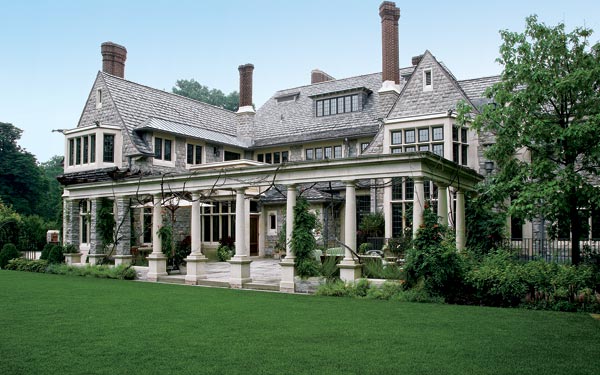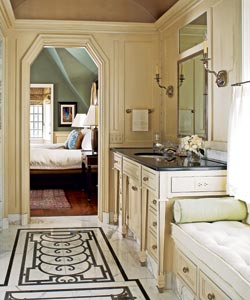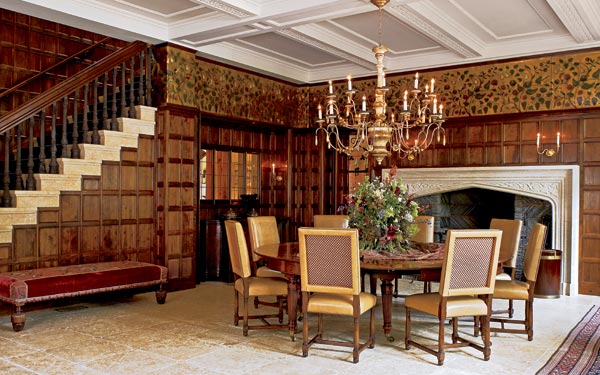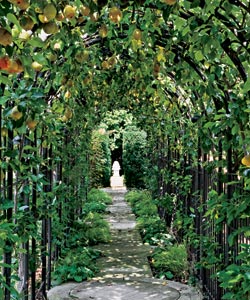
The back of the house is distinctly English, with tall brick chimneys and a slate roof, a columned pergola and long lines of faceted windows. Photo Gallery::: |
Behind a tangled hedgerow in the very English countryside of West Sussex sits an achingly beautiful house whose visitors are cheerily asked to ignore the ghost sometimes heard weeping on the staircase.
That’s the kind of English country house experience that either charms the heck out of you or sends you screaming to your car.

The design of the floor in the master bathroom, inlaid with nickel filigree, was drawn from a railing pattern Jennifer Litowitz saw on the PBS series Manor House, filmed at Scotland’s Manderston House. The bathroom ceiling is done insilver-leaf wallpaper. Photo Gallery::: |
Jennifer and Alec Litowitz are among the fearless former, and they’ve even conjured up their own apparition right here on the North Shore. It’s a painstakingly detailed interpretation of that Sussex house, Little Thakeham, built in 1903 by the famed architect Sir Edwin Lutyens. "We always dreamed of living in a house like this," says Jennifer Litowitz, though she laughs that the original "is probably pretty drafty."
Dream in hand, in 2002 the Litowitzes approached interior designer Heather G. Wells and architects Phillip Liederbach and Michael Graham and asked them to create a suburban Chicago version of the idyllic English country houses they loved.
"Everything had to be authentic" (except ghosts and drafts, one assumes), says Wells, who’s known as much for her unabashed love of history as for her star-studded client list, so she was thrilled when the Litowitzes suggested a road trip. Before committing pen to paper, the designer, her senior partner, Bruce Fox, the architects, and the Litowitzes went roaming the narrow country lanes of the English countryside in the company of a Lutyens expert.
"When we arrived at Little Thakeham, a worker was repairing the fireplace," says Fox, "and he gave us a small piece of stone as a memento." That fragment of Little Thakeham became, quite literally, the design touchstone for the Litowitzes’ new home, inspiring everything from the fireplaces to the color of the façade.
"After that trip, the project really picked up momentum," says Jennifer Litowitz. "It just kept growing and becoming more detailed as we did more and more research." The result is 10,000 square feet of manor house filled with obsessively intricate details and a mother lode of important European antiques, but it’s hardly a please-do-not-touch museum diorama. The house pays homage to family life as well as to Lutyens. "We built it first and foremost for our kids," says Litowitz, the mother of four boys who range in age from three to ten.
Take the walnut-paneled dining room with its two enormous limestone fireplaces; it looks like an imposing "great hall," but the flotsam of family life scattered around humanizes the formality. "Our kids go everywhere," admits Litowitz. "Nothing is off limits." The room’s massive 1820s-era Cuban mahogany table is typically hidden beneath layers of school projects; throw in some juice boxes and Magic Markers and the possibilities are pretty terrifying.
Interior Photography: Alan Shortall
Garden Photography: Linda Oyama Bryan
Related:

The dining room’s rich geometric walnut paneling provides a counterpoint to the English Country–style gilded leather cornice and pristine white ceiling. The chandelier is an Italian antique; the chairs are reproductions by Gregorius Pineo. Photo Gallery::: |
"That table is the defining piece in the house," notes Wells. "I found it in a Pimlico Road antique shop in London, and there’s nothing like it anywhere. It was the largest round table made in Europe at the time. With its three leaves in, it can seat 20, no problem."
Any piece that has survived almost 200 years and four small boys must be pretty tough. "What’s really great about this style of antiques is that they’re very sturdy," Litowitz says. "I don’t worry about permanent damage." (Note the qualifying "permanent.") Happily, the gilded decorative leather wall treatment depicting the Tree of Life that tops the dining room walls is beyond the reach of marauding hockey sticks. "It was handmade in England by a very persnickety old lady," says Fox. "Embossed leather like this was an English tradition, but it’s really a dying art."

Garden designer Craig Bergmann created an espaliered Kieffer pear arbor. "I lifted the idea from the Cantigny Park garden in Wheaton," he says. Photo Gallery::: |
For their part, the boys don’t seem much distracted by the golden glow of the moldings as they tear across French limestone floors to the billiards room. Here Wells applied striped mohair fabric to the walls to "soften the sound of the pool balls during play" and built a platform into the window alcove so bystanders could view the game from a bird’s-eye seat. The room is even outfitted with a drinks rail—an extra-wide wainscot molding with a cork inlay to absorb any stray moisture from players’ tankards.
With so many details derived from architectural history books, you might expect some degree of predictability, but everywhere Wells and Fox leaned on tradition they were also careful to give it a fresh spin. The living room’s leaded-glass windows are draped in a lively Fortuny fabric, and the kitchen walls are lined in colorful Italian tiles. In the living room, two swoopy Biedermeier chairs sit in for a piano bench for a little four-handed chopsticks; the dramatic double-height library got a sweet and delicate Russian tole chandelier.
The most surprising and eccentric carryover from Little Thakeham and its kin, though, are the secret passages and hidden rooms so beloved by the English gentry. Down one paneled hall, the press of a small button and a well-placed shove reveal a fully stocked bar. "It’s in the tradition of the bars people had in Chicago during Prohibition," says Wells. The kind of spot where Mr. Darcy could take cigars and port with Mr. Capone, one presumes. On the opposite side of the hall, another hidden door swings open onto a spiral staircase whose blue felt-lined walls lead up to a balcony overlooking the library and down to a magnificent stone-walled wine tasting room.
Naturally, every estate house needs an estate, and just as Lutyens enlisted great landscape designers like Gertrude Jekyll for his projects, the Litowitzes engaged a local garden legend, Craig Bergmann, to take on their home’s exteriors. Bergmann produced a landscape of sweeping lawn, pergola, and gardens that play up the house’s fairy-tale charm. Wisteria scrambles up the copper downspouts, European hornbeams camouflage the garage, and one walks to the pool beneath the impossible splendor of an espaliered pear tree arbor that groans with fruit in the summer.
"I think informal plantings soften the edges, loosen up the formality, and help the house not to feel so new," says Bergmann, who also created playful follies like a woodland garden featuring a stone village and an arched wooden door in the pool enclosure’s wall. "It doesn’t go anywhere; it opens onto the neighbor’s paling fence," says Bergmann. "It’s simply a point of interest."
Actually, there are enough points of interest here to make your head spin, but the overall effect is seamless. "The Litowitzes had a very specific vision," Wells says. "It never varied." Inside and outside this grand home that vision is obvious, the illusion complete. The Chicago suburban grid fades, replaced by a very authentic English focus on place, comfort, and family. Now let’s just hope Little Thakeham’s ghost doesn’t decide to come touring.
For resource information, see Buyer’s Guide.
Interior Photography: Alan Shortall
Garden Photography: Linda Oyama Bryan
Related:


